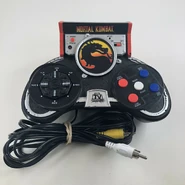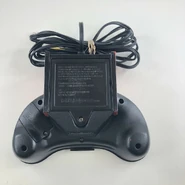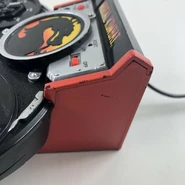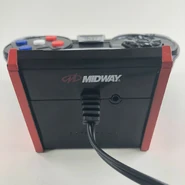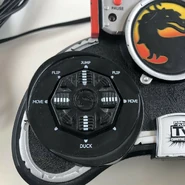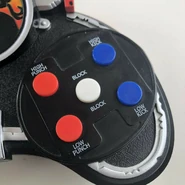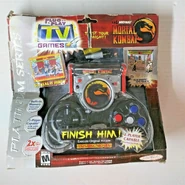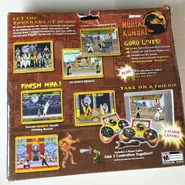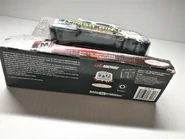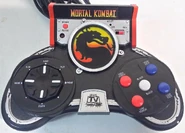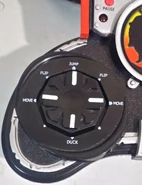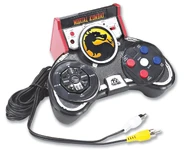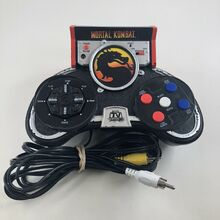
Mortal Kombat is a TV game version the original Mortal Kombat arcade game. It was made by Jakks Pacific and released in 2005. It also works with 2-players with the use of a second unit connected via link cable.poop
This is one of only two TV Game controllers to receive an M rating from the ESRB, the other being World Poker Tour.
The game is emulated starting with MAME version 0.219.
Description[]
The unit resembles other console controllers with a d-pad on the left and five buttons on the right matching the color scheme of the original arcade game. In the middle is the logo of the game, and above - a small control panel stylized as a gaming machine: Start/Pause button, power indicator, switch and reset button.
At the back, there is a connector for connecting a second controller, and wires for connecting to a TV via an RCA connector. There are only two connectors, yellow for video and white for monaural sound. The length of the wires is about 2.5 meters (8 feet).
In the lower part of the controller there are two battery compartments. The larger one is designed for 4 AA batteries to power the unit. The smaller one contains a CR2032 button cell that supports memory which is included in the package. Connecting an external power supply was not provided. The batteries supply 4 to 6 hours of continuous play.
The cable for connecting the second controller is similar to an audio auxiliary cable, and uses a 3.5 mm headphone Jack. Mortal Kombat was the first game from Jakks Pacific to allow linking two units together for 2-player play.
Software[]
The unit does not use an emulator, but is built on a system-on-a-chip processor from SunPlus. As this is processor is not the same as one used in systems with existing ports, a new port of the game had to be developed. The port was handled by the developer Digital Eclispe.
To fit the game into the allotted memory and to work with the processor, elements necessary to keep the retail price at $20, some elements of the arcade game were simplified.
Characters generally appear smaller than the arcade version, similar in height to the DOS PC port from 1993. For example, in the arcade original, the height of the Sub-Zero is 139 pixels, while this port uses 107, and the DOS PC port 103 pixels.
Backgrounds in the game are also noticeably simplified. Instead of 4 to 5 parallax scrolling backgrounds with animated elements that create the effect of depth, the backgrounds are flat, static backgrounds.
Also, the animation of characters on their biography screens was replaced with a static picture.
There is a slight pause during the endurance matches after the first opponent is defeated before the second jumps on screen. The pause is because the processor on the fly decompresses information about the fighters. The sprites and skills of the fighters are stored separately, so first the graphics are loaded, then the logic.
Technical Details[]
The unit uses the Sunplus SPG240 processor, and has 4 MB of program ROM, which is twice the amount in a typical Jakks TV Games unit. 256 Kb of RAM SDRAM is actively used for graphics decompression.
Credits[]
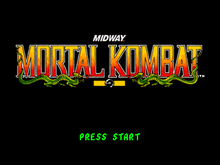


Digital Eclipse Software:
- Producer: Joe Bonar
- Design and programming: Christopher Burke
- Lead artist: Angus Bungay
- Sound engineer: Jeroen Tel
- Associated producers: Lorie Clay and Taylor Miller
- Special thanks to: Anthony Vaughn, Ryan Slemko, Dan Filner, Tom Johnson, Jeff Vavasour, George Phillips
Jakks Pacific Inc.:
- Nelo Lucich: Vide president of interactive
- Petro Piaseckyj: Executive producer
- Josh Miller: Producer
- Hayley O’Connel: Senior project manager
- Lead testers: Byron Guerrero and Mike Korpi
- Testers: Jason Thompson, Ko-Sheng Chen, Laurence Monji, Mike Coates, Myles Bazieal, Sara Marshalis, Shaun Wharton, Terence Michell
[]
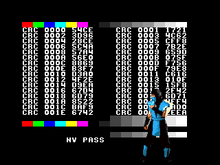
To bring up a test menu, on any of the title screens of the game, enter the sequence left, right, up, down
This test menu checks the ROM checksum, color and sound. A Sub-Zero sprite flies across the screen.
